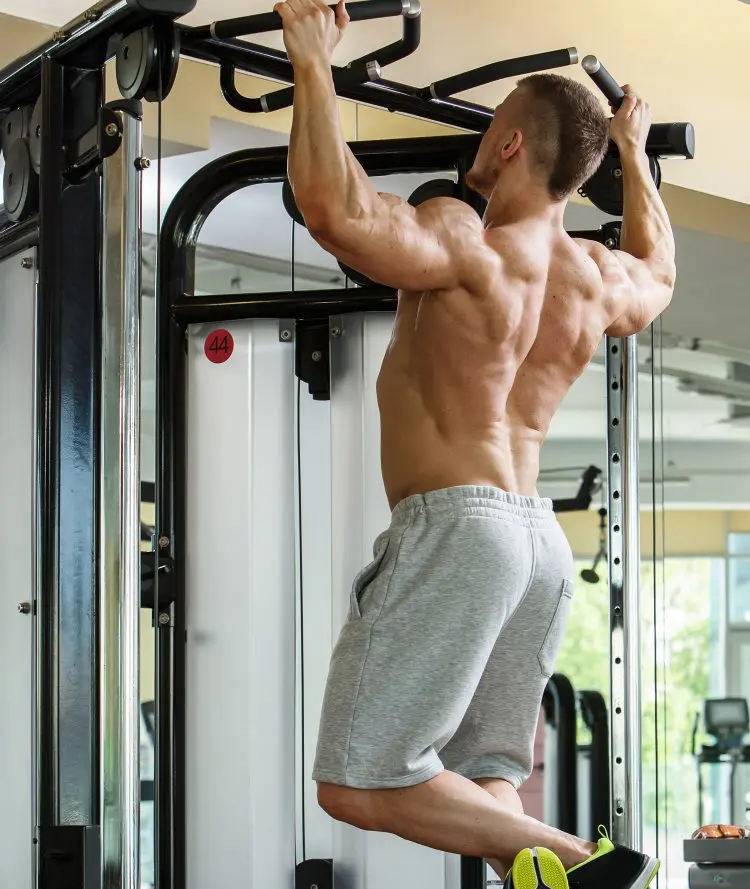Pull-ups are, in my experience as an ACE-certified personal trainer, one of the all-time best back and biceps exercises. Consequently, I often include them in my client’s workouts. They’re also one of my favorite upper-body exercises, so they often feature in my own training.
However, as great as pull-ups are, I also understand that they are impractical for some people. After all, you need a pull-up bar to do them, which may not be available if you train at home. In addition, you must be strong enough to lift your entire body weight with just your arms. As such, they may be beyond the ability of heavier or less experienced exercisers.
The good news is that pull-ups are not compulsory, and there are plenty of other ways you can train your back and biceps.
In this article, I share my 12 favorite pull-up alternatives. Use these exercises in place of pull-ups, or to build the strength necessary to eventually master this popular but challenging exercise.
What Is A Pull-up?

Even before we put together this list of best pull-up alternatives, we had to consider everything that makes the pull-up what it is.
Mostly everyone who hasn’t been living under a rock knows that a pull-up is when you pull yourself up using an overhead bar.
Level Up Your Fitness: Join our 💪 strong community in Fitness Volt Newsletter. Get daily inspiration, expert-backed workouts, nutrition tips, the latest in strength sports, and the support you need to reach your goals. Subscribe for free!
However, they may also use the term pull-up to describe a chin-up. But there is a difference.
Hand position
- The pull-up is performed using a pronated or overhand grip.
- The chin-up is performed using a supinated or underhand grip.
Read more about pull-ups vs. chin-ups here.
Grip width
Due to the difference in hand position, the body mechanics seem to change when it comes to performing either one.
For example, have you ever tried to do a very close-grip pull-up using an overhand grip? It’s probably very uncomfortable and, many times, impossible (not always, though).
But doing super close grip chin-ups with the hands touching on the bar is easy peasy.
This is probably due to the fact that when the palms are facing away from you, the biceps are at a mechanical disadvantage.
Need a pull-up bar? Check out our pull-up bar reviews in a variety of categories.
Similarly, you couldn’t do a very wide chin-up, whereas you could with an overhand pull-up grip.
Muscle involvement
The pull-up and chin-up work all of the same muscles; however, they work a little differently.
For example, using a wide, overhand grip for the pull-up actually incorporates more of the teres major, due to its location (below the armpit) and function.
The teres major is a shoulder muscle that functions to pull the upper arm back into extension and rotate it medially or inward towards the trunk.
Normally, the lats take over as the dominant muscle when performing pull-ups using a close and medium grip. But when using a wider grip, this smaller muscle takes on more responsibility.
This may also be explained by the fact that it’s harder to do pull-ups with the hands positioned farther apart than shoulder-width.
Related: The 12 Best Teres Major and Teres Minor Exercises
Choosing The Best Pull-Up Alternatives
In making our pull-up alternative exercise selections, there were a few essential criteria.
For instance, all exercises must work the back muscles. While the biceps and forearms do get heavy engagement when performing pull-ups, I think we can all agree that the primary focus is the muscles of the rear.
Therefore, not all of these exercises involve using your grip to pull, but most of the alternatives that you’ll find on this list do.
The only other thing we considered was offering options for everyone. You certainly do not need to be able to perform a single pull-up to do many of these.
However, if you simply want an alternative to the bodyweight bar pull-up, then we included some of those, too, like the chin-up, door pull-up, and inverted row variations.
1. Cable pulldown
One of the more popular back exercises, the cable pulldown is the pull-up in reverse.
One advantage the cable pulldown has over machines and even the pull-up is you have lots of different attachment options. You can work the same muscles using a long bar or lat attachment, EZ-bar, individual handles, double D handle rope, and more.
You can also lift super heavy and then perform multiple drop sets. But if you have no interest in doing pull-ups anyway, the cable pulldown and its variations are great lat exercises that many will choose any day over trying to pull themselves up to a bar, even if assisted.
2. Inverted row
The inverted row is a solid pull-up alternative exercise, also known as the Australian pull-up, horizontal row, and sometimes fat man row is probably the next best thing to the bodyweight pull-up.
In fact, it’s probably what the knee push-up is to a full, proper push-up. That’s because it removes a percentage of your body weight resistance which makes it easier to do.
And, like with push-ups, you can position your upper body more upright and this makes it possible to do even for those with very little upper body strength.
There are so many different variations of the inverted row. Here’s a list of the different things you can use.
- Smith machine bar
- Sturdy table
- Recreational park bars
- Barbell supported by a rack
- Mop handle and chairs or kitchen counters
- TRX or suspension trainer
3. Suspension pull-up
Suspension trainers have become very popular training tools that use your own body weight as resistance. You can adjust the length of the straps and the position of your body to replicate almost every machine strength training exercise.
There are some unique suspension trainer exercises, too. This leg-assisted pull-up is a great pull-up alternative for anyone not quite strong enough to do full-bodyweight pull-ups.
You can find some of the best suspension trainer back exercises and pull-up alternatives in this guide.
4. Chin-up
Many actually prefer the chin-up over the pull-up, and for good reason. This is one of the best pull-up alternatives. For one, many find it stretches the lat muscles better than the pull-up. The eccentric or stretch component may be just as important as the concentric or contraction (1, 2).
And because it’s essentially a bodyweight biceps curl, the chin-up is an exceptional biceps exercise when done right.
If you cannot do a full bodyweight chin-up, no worries, there are easier variations. You could use a Smith machine or something similar and perform chin-ups by hanging your body from underneath as you would the inverted row.
Since your body is angled and your heels are kept on the ground, this will remove a percentage of your body weight.
Also, check out: The Chin-Ups For Size and Strength Guide
5. Band-assisted pull-up
The hardest part of pull-ups is overcoming your own body weight. Whether you are a beginner or just a little on the heavy side, this is a significant feat of strength.
While you can use an assisted pull-up machine to counterbalance some of your weight, this may not be an option if you train at home.
So, alternatively, you can use a loop-type resistance band to give you a boost.
This is an excellent option for anyone who wants to learn how to do pull-ups but is currently not strong enough to do them unaided. Gradually wean yourself off the assistance until you can do pull-ups using muscle power alone.
6. Door pull-up
Not having a pull-up bar is no excuse for not being able to do pull-ups. Although, this could certainly depend on your living situation and how strong the doors are.
But you could place a towel or something soft at the top of the door and do pull-ups.
It may not be as comfortable since the front side of your body will be sliding against the door, but it’s really not too bad. While this is not my preferred alternative to pull-ups, it’s certainly a viable option for emergencies.
7. Reverse elbow push-up
If you have absolutely no equipment and need a way to work your back muscles, then reverse elbow push-up is a good pull-up alternative. Although, you can also use two chairs or benches and place yourself in between them for a larger range of exercise motion.
But you’re pretty much doing a reverse push-up as the name suggests, and instead of using your arms, you’re driving your elbows into the floor to lift your torso off the ground.
It’s not easy, which is good because you need a challenge to overload your muscles and, therefore, build muscle and strength.
Level Up Your Fitness: Join our 💪 strong community in Fitness Volt Newsletter. Get daily inspiration, expert-backed workouts, nutrition tips, the latest in strength sports, and the support you need to reach your goals. Subscribe for free!
To do it:
- Lie on your back with your elbows out at a roughly 45-degree angle to your body.
- Drive your elbows into the ground to lift your upper body. Hold for a second or two.
- Slowly return to the starting position and repeat for the desired number of reps.
You can also make this exercise easier by bending your knees or doing it using a wall. Simply face away from the wall, place your elbows against and push into it. It’s the same idea.
8. Front lever raise
This bodyweight gymnastics movement is even more challenging than the pull-up. Therefore, you’ll need to be of an advanced fitness level to do it.
It requires total body strength and skill, and while it doesn’t replicate the pull-up motion, it is a killer lats and overall back movement.
Learn all about the front lever raise in this guide.
9. Negatives from a bar
These are great for building pull-up strength. Grab onto the bar, jump yourself up as high as you can, and then fight against your body weight, trying to pull you back down. You can use a chair, bench, stool, or anything to help you up.
One common mistake that people make when doing negatives is they get impatient and drop down too quickly, even if they have the strength to hold themselves up for a little longer.
By trying to hold yourself up longer, you’ll not only develop more physical strength but mental strength as well, and this plays a big role when it comes to getting the most from pull-ups.
Most probably don’t realize it but doing complete pull-ups challenges mental fortitude.
10. Rows
If you want to build an amazing back, then rows are a must. There are so many different variations, too, which means you’ll never get bored training your back, and if you don’t like a specific row exercise, well, there are tons of others to choose from.
Row variations:
- Barbell bent-over row
- Dumbbell bent-over row
- Cable row variations
- Yates row
- Pendlay row
- Kroc row
- Seal row
- Renegade row
- Machine row
- Landmine row
- Doorway row/pull-up
11. Seated pike pull-ups
Seated pike pull-ups let you mimic regular pull-ups while keeping your feet on the floor. As such, you don’t have to lift your entire body weight when you do them. This is a great exercise for beginners and heavier individuals. I also like it for warming up before full pull-ups, and using afterward when I’m feeling tired.
12. Deadlifts
We’re not referring to the Romanian deadlift, stiff-legged deadlift, or any other hip hinge exercise other than a conventional deadlift.
Having to pull heavy weight from the ground requires a different level of effort and maximally engages your upper body pulling muscles.
There’s a reason you can lift more pulling weight from the ground and why the conventional deadlift is a contested lift in powerlifting, and part of Strongman, weightlifting, and CrossFit performance.
The deadlift is an amazing back and total body exercise.
You can use a straight barbell, trap bar, dumbbell, Smith machine, or anything that allows you to start from a low and requires total body recruitment.
Deadlift Form 101: How to Lift More Weight Safely
What Muscles Do Pull-ups Work?
It takes several muscle groups working together to perform a pull-up.
Back Muscles
The back is put together by several muscles between the neck and torso. Here’s a brief summary of the muscles involved in pull-ups to help you place your focus accordingly.
Latissimus dorsi likely benefits the most from pull-ups, according to research. As a matter of fact, a study by the American Council on Exercise put this to the test by comparing back muscle activation using various movements. (3). Well, the pull-up blew away the competition when it came to activating the lat muscles.
Lats are the wing-like muscles that cover both the upper and lower back and connect the upper extremities to the vertebral column on the back. These muscles are involved in movements where the arms are positioned overhead, like during a pull-up. However, any back exercise will involve the lats.
Rhomboids are upper back muscles made of a major and minor that help us to move the upper limbs and stabilize the shoulder girdle and shoulder blades with the aid of the trunk. We need rhomboids to perform all pulling movements.
Trapezius are the muscles we focus on when performing shrugs. However, pull training sessions are going to stimulate the traps too. Traps are split into three sections – upper, middle, and lower fibers.
Upper fibers push the scapula up, middle fibers pull it back, and lower fibers draw it down.
Deltoid posterior
Pull-ups aren’t seen as a shoulder exercise. However, anytime you pull your arms behind your body, the posterior head of the deltoids will come to life. Being a typically underdeveloped muscle, this is a good thing.
Biceps
You can kill two birds with one stone by incorporating pull-ups into your workouts. You’ll get an amazing back workout while building your biceps muscles. The biceps are two heads on the front of the upper arm that flexes when you make a muscle. Its role is to flex the elbow and turn the forearm left and right depending on its position. The biceps also cross the shoulder joint but don’t do a lot at the upper end of the humerus (upper arm).
Brachialis
A significant muscle in the upper arm and forearm, the brachialis sits behind the outer biceps and shoots down through the elbow joint. It’s the strongest elbow flexor and adds mass to the upper arm too.
Forearms
There are many forearm muscles that help to operate the lower arm. The brachioradialis is one of the most important aesthetic forearm muscles located on the lateral and upper forearm. It’s also an elbow flexor.
Core
The core is more important than we realize. In fact, during every full body exercise it’s working to keep us stable and strong to allow the lower and upper limbs to do their thing. These muscles include abdominals, obliques, and even the back muscles that line the length of the spine.
However, pull-ups are not an abs-focused exercise.
Read also:
- Best Hammer Strength Lat Pull Alternative Exercises
- Lat Pulldown Alternative Exercises for A HUGE Back
- T-Bar Row Alternative For a Massive Back
- Best Chin-Up and Pull-Up Variations for a Bigger and Stronger Back
- What is the Best Chin-up and Pull-up Alternative?
Pull-Up Alternative FAQs
Do you have a question about the pull-up alternatives listed in this article? No problem, because I’ve got the answers! Need more info? Drop me a line in the comments section below, and I’ll get back to you ASAP.
1. What exercises can I do if I can’t do pull-ups?
While pull-ups are an effective exercise, they’re not the only way to build a stronger, more muscular back. In fact, any combination of vertical and horizontal pulling exercises will enhance back size and shape. Personally, I favor exercises that closely mimic the pull-up and treat rowing exercises as a different movement classification. The closer the exercise is to pull-ups, the happier I am.
Therefore, my preferred pull-up alternatives are:
- Lat pulldowns
- Band and machine-assisted pull-ups
- Doorway pull-ups
- Seated pike pull-ups
- Negative pull-ups
- Chin-ups
In my opinion, these are the absolute best alternatives because they most closely mirror the demands of pull-ups. There are other exercises that work the same muscles, but these use the most similar movement pattern.
2. How do I get better at doing pull-ups
Just because you can’t do many (or any) pull-ups right now doesn’t mean this exercise will always be beyond your grasp. In fact, I’ve helped many people achieve their first pull-up, and getting to ten is a common goal for my clients.
Here are a few tips on getting better at pull-ups:
- Perfect your form – it makes pull-ups easier to do.
- Lose weight – nothing makes pull-ups harder than being too heavy.
- Practice – you’ll get better at pull-ups sooner if you do them more often.
- Follow a progressive pull-up program – here’s one to try!
- Build strength – use the alternatives in this article to strengthen the relevant muscles.
- Be persistent – don’t worry if you find pull-ups difficult; you are not alone. Stick with it, and you WILL master this exercise.
Learn more about improving your pull-up performance in this detailed guide.
3. Do I have to do pull-ups to build a muscular back?
Contrary to what you might have heard, pull-ups aren’t the only way to build a bigger, more muscular back. In fact, they’re one of the many exercises you can use for this purpose.
So, while pull-ups are great, you don’t have to do them if you don’t want to. Some of the biggest bodybuilders and powerlifters can’t do them very well because of their massive body weight.
So, while I love pull-ups, that doesn’t mean everyone shares my opinion. Pick the exercises that best match your needs and goals, and don’t worry if you find pull-ups impractical or uncomfortable. You can develop a great back without them.
4. How many sets and reps of these pull-up alternatives should I do?
Because most of these alternatives use body weight for resistance, you should do as many reps as you can rather than aiming for a specific number. For example, I could tell you to do ten, but that may be too many for some people and too few for others. Continue your set until you are within 1-3 reps of failure.
Regarding sets, 3-5 should be sufficient for most people. However, you can get good results by doing as few as 1-2 sets.
5. Are pull-ups a safe exercise?
In my opinion and experience, pull-ups are a reasonably safe exercise. Done correctly, they are joint-friendly, and there are no heavy weights to drop on you. However, doing pull-ups too often can cause elbow pain, which can take a long time to heal.
This is a common problem for calisthenics athletes who do a lot of pull-ups. One way around this is to vary your grip from workout to workout, do chin-ups and rows as well as pull-ups, and make sure you respect your body’s need for rest and recovery.
So, like any exercise, pull-ups are mostly safe, but you still need to pay attention to your form and training volume and intensity to avoid unnecessary aches and pains.
Wrapping Up
If you were looking for the top pull-up alternatives, you came to the right place!
It doesn’t matter what your level of fitness is or whether or not you can do a bodyweight pull-up, there are options for everyone.
Each of these exercises works the same muscles as pull-ups, so you can use them for any workout where pull-ups are prescribed. There are gym and home options to choose from, and exercises for beginner, intermediate, and advanced lifters.
I’ll always love pull-ups, but I also acknowledge that they aren’t for everyone. So use these pull-up alternatives to build the back and biceps of your dreams.
References:
- Franchi MV, Reeves ND, Narici MV. Skeletal Muscle Remodeling in Response to Eccentric vs. Concentric Loading: Morphological, Molecular, and Metabolic Adaptations. Front Physiol. 2017 Jul 4;8:447. doi: 10.3389/fphys.2017.00447. PMID: 28725197; PMCID: PMC5495834.
- Schoenfeld, Brad J.1; Ogborn, Dan I.2; Vigotsky, Andrew D.3; Franchi, Martino V.4; Krieger, James W.5. Hypertrophic Effects of Concentric vs. Eccentric Muscle Actions: A Systematic Review and Meta-analysis. Journal of Strength and Conditioning Research 31(9):p 2599-2608, September 2017. | DOI: 10.1519/JSC.0000000000001983
- Holly Edelburg, B.S., John P. Porcari, Ph.D., Clayton Camic, Ph.D., Attila Kovacs, Ph.D., Carl Foster, Ph.D., Daniel J. Green. What Is the Best Back Exercise? American Council on Exercise.
Article Updates Timeline:
Our editorial team experts constantly update the articles with new information & research, ensuring you always have access to the latest and most reliable information.
December 27, 2023
Major Update By
Patrick Dale, PT, ex-Marine
December 29, 2022
Updated By
Matthew Magnante, ACE
April 10, 2022
Updated By
Tom Miller, CSCS
August 6, 2021
Written By
Matthew Magnante, ACE
Interested in measuring your progress? Check out our strength standards for Push Ups, Machine Row, Pendlay Row, and more.











